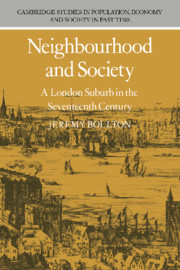Book contents
- Frontmatter
- Contents
- List of figures
- List of tables
- Preface
- Abbreviations
- 1 Introduction
- 2 The demographic background
- 3 Earning a living in early seventeenth-century Southwark
- 4 Wealth and social structure
- 5 Household structure and the household economy
- 6 Power, status and social mobility
- 7 Residential patterns and property ownership
- 8 The dynamics of a local community
- 9 Social relationships in the urban neighbourhood
- 10 The institutional structure of the neighbourhood
- 11 Conclusion: neighbourhood and society in seventeenth-century London
- Bibliography
- Index
11 - Conclusion: neighbourhood and society in seventeenth-century London
Published online by Cambridge University Press: 19 October 2009
- Frontmatter
- Contents
- List of figures
- List of tables
- Preface
- Abbreviations
- 1 Introduction
- 2 The demographic background
- 3 Earning a living in early seventeenth-century Southwark
- 4 Wealth and social structure
- 5 Household structure and the household economy
- 6 Power, status and social mobility
- 7 Residential patterns and property ownership
- 8 The dynamics of a local community
- 9 Social relationships in the urban neighbourhood
- 10 The institutional structure of the neighbourhood
- 11 Conclusion: neighbourhood and society in seventeenth-century London
- Bibliography
- Index
Summary
Demographically Southwark and its component parts were very much part of the metropolitan whole. Like London, Southwark's population increased most rapidly in the second half of the sixteenth century and grew progressively more slowly as the seventeenth century wore on. The district, however, always increased at a slower rate than the capital, although faster than its central areas. In the early seventeenth century about one in ten of London's population lived in one of the four Southwark parishes. St Saviour's, Southwark, containing more than a third of Southwark's total population, displayed a pattern of population growth similar to that of the rest of London. The parish, to a striking degree, also shared in the demographic experience of the capital, experiencing similar mortality crises and seasonal patterns of births and deaths. Epidemic disease seems to have been largely an autonomous influence over the lives of the inhabitants of St Saviour's. The latter did not suffer unduly in periods of hardship caused by cold weather, depressions in the cloth industry or high bread and fuel prices. Members of this society gained more protection against these latter types of hardship than the inhabitants of some rural communities.
Such resilience seems to have derived in part from the protection conferred by local government institutions, poor relief administration and the provision of subsidised fuel. Evidence from the Boroughside district of St Saviour's, the subject of an intensive area study, also suggested that the local economy possessed more in-built flexibility than has been supposed hitherto.
- Type
- Chapter
- Information
- Publisher: Cambridge University PressPrint publication year: 1987

